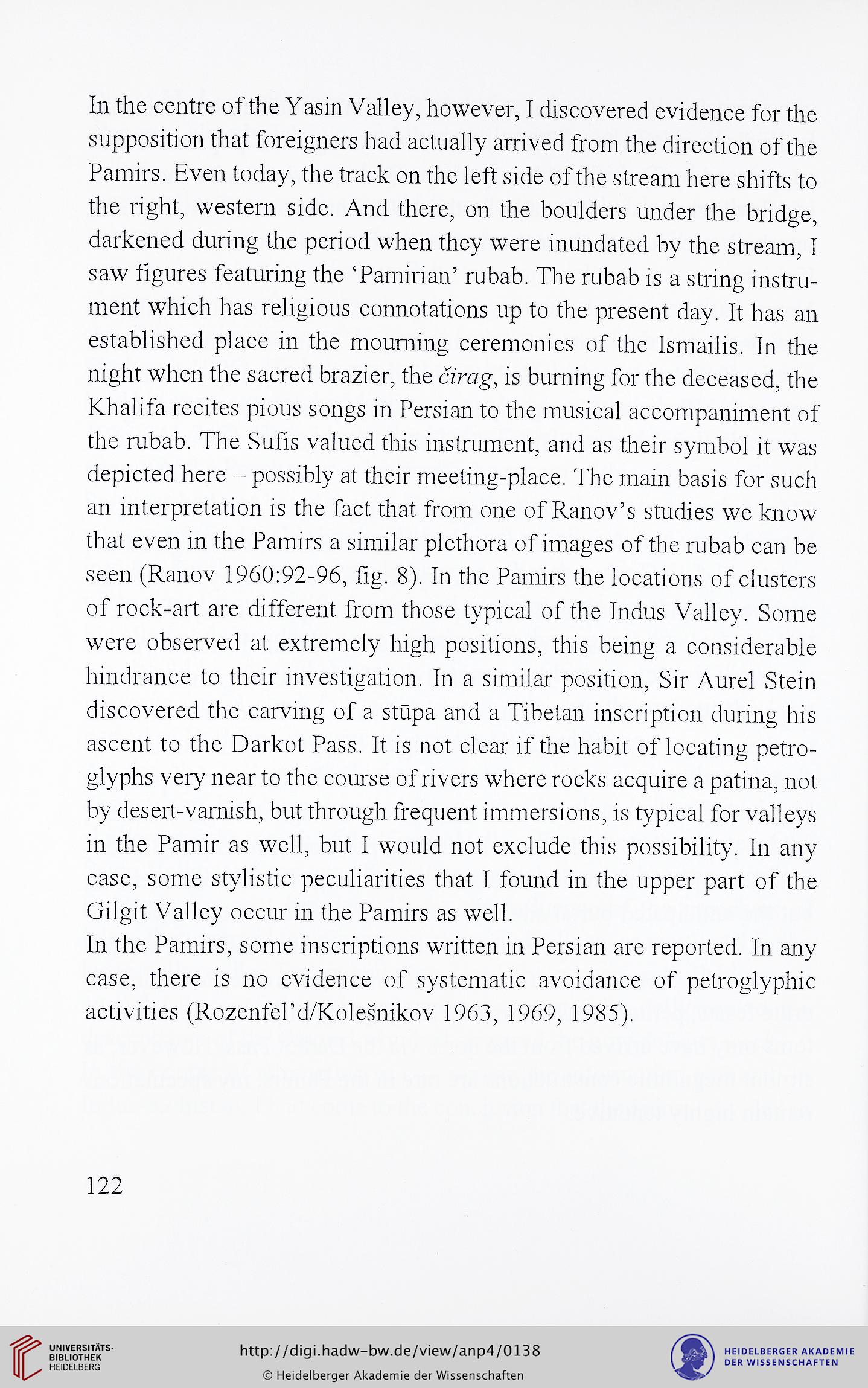In the centre of the Yasin Valley, however, I discovered evidence for the
supposition that foreigners had actually arrived from the direction of the
Pamirs. Even today, the track on the left side of the stream here shifts to
the right, western side. And there, on the boulders under the bridge,
darkened during the period when they were inundated by the stream, I
saw figures featuring the 'Pamirian' rubab. The rubab is a string instru-
ment which has religious connotations up to the present day. It has an
established place in the mourning ceremonies of the Ismailis. In the
night when the sacred brazier, the cmug, is burning for the deceased, the
Khalifa recites pious songs m Persian to the musical accompaniment of
the rubab. The Sufis valued this instrument, and as their symbol it was
depicted here - possibly at their meeting-place. The mam basis for such
an interpretation is the fact that from one of Ranov's studies we know
that even m the Pamirs a similar plethora of images of the rubab can be
seen (Ranov 1960:92-96, fig. 8). In the Pamirs the locations of clusters
of rock-art are different from those typical of the Indus Valley. Some
were observed at extremely high positions, this being a considerable
hindrance to their investigation. In a similar position, Sir Aurel Stem
discovered the carving of a stupa and a Tibetan inscription during his
ascent to the Darkot Pass. It is not clear if the habit of locating petro-
glyphs very near to the course of rivers where rocks acquire a patina, not
by desert-vamish, but through frequent immersions, is typical for valleys
m the Pamir as well, but I would not exclude this possibility. In any
case, some stylistic peculiarities that I found in the upper part of the
Gilgit Valley occur m the Pamirs as well.
In the Pamirs, some inscriptions written in Persian are reported. In any
case, there is no evidence of systematic avoidance of petroglyphic
activities (RozenfePd/Kolesnikov 1963, 1969, 1985).
122
supposition that foreigners had actually arrived from the direction of the
Pamirs. Even today, the track on the left side of the stream here shifts to
the right, western side. And there, on the boulders under the bridge,
darkened during the period when they were inundated by the stream, I
saw figures featuring the 'Pamirian' rubab. The rubab is a string instru-
ment which has religious connotations up to the present day. It has an
established place in the mourning ceremonies of the Ismailis. In the
night when the sacred brazier, the cmug, is burning for the deceased, the
Khalifa recites pious songs m Persian to the musical accompaniment of
the rubab. The Sufis valued this instrument, and as their symbol it was
depicted here - possibly at their meeting-place. The mam basis for such
an interpretation is the fact that from one of Ranov's studies we know
that even m the Pamirs a similar plethora of images of the rubab can be
seen (Ranov 1960:92-96, fig. 8). In the Pamirs the locations of clusters
of rock-art are different from those typical of the Indus Valley. Some
were observed at extremely high positions, this being a considerable
hindrance to their investigation. In a similar position, Sir Aurel Stem
discovered the carving of a stupa and a Tibetan inscription during his
ascent to the Darkot Pass. It is not clear if the habit of locating petro-
glyphs very near to the course of rivers where rocks acquire a patina, not
by desert-vamish, but through frequent immersions, is typical for valleys
m the Pamir as well, but I would not exclude this possibility. In any
case, some stylistic peculiarities that I found in the upper part of the
Gilgit Valley occur m the Pamirs as well.
In the Pamirs, some inscriptions written in Persian are reported. In any
case, there is no evidence of systematic avoidance of petroglyphic
activities (RozenfePd/Kolesnikov 1963, 1969, 1985).
122




